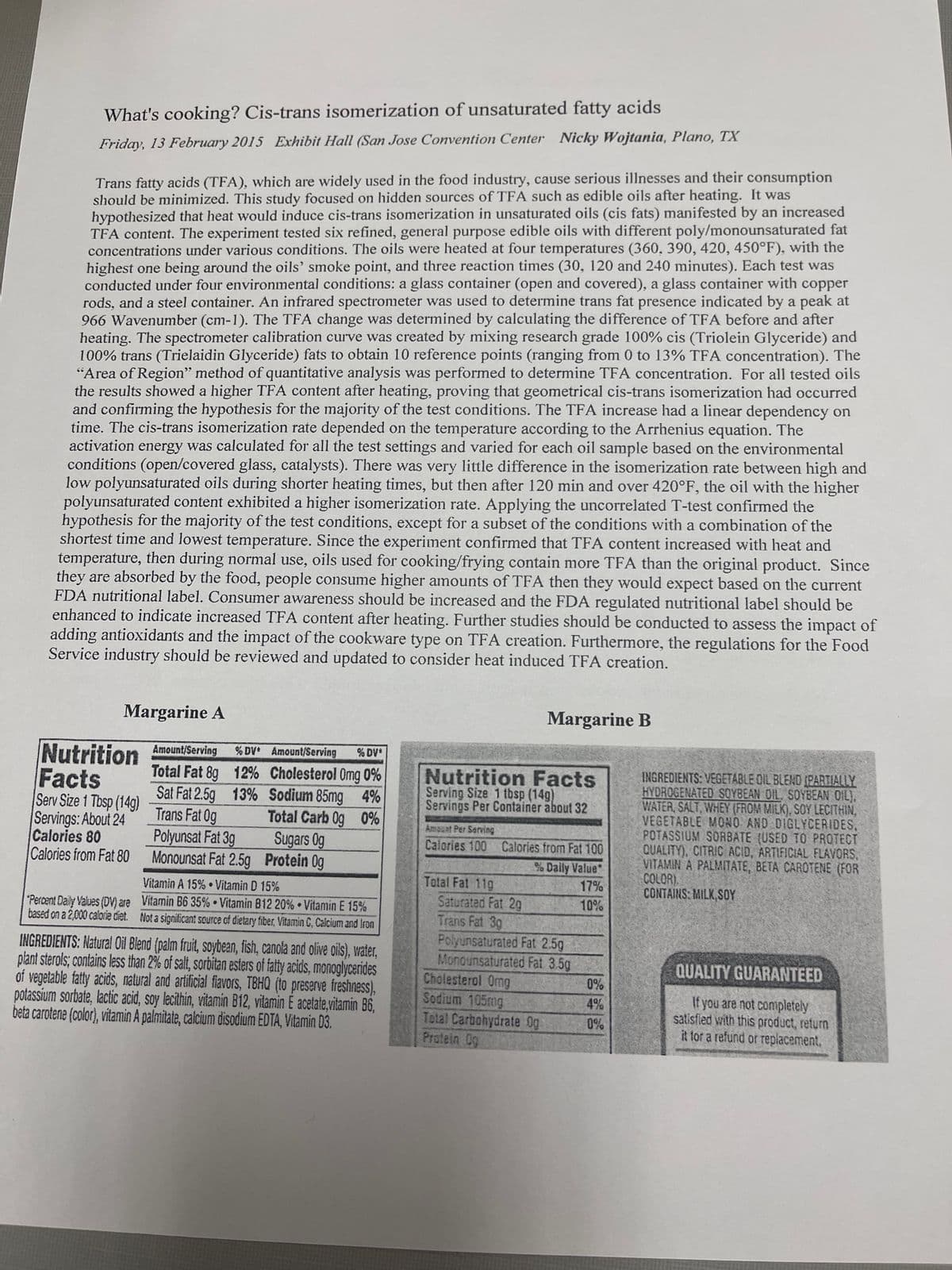Based on their fat content, which is the healthier option? Explain your answer. - Based on all of the nutritional information, which do you think is the healthier option? Explain your answer.
Based on their fat content, which is the healthier option? Explain your answer. - Based on all of the nutritional information, which do you think is the healthier option? Explain your answer.
Biochemistry
6th Edition
ISBN:9781305577206
Author:Reginald H. Garrett, Charles M. Grisham
Publisher:Reginald H. Garrett, Charles M. Grisham
Chapter24: Lipid Biosynthesis
Section: Chapter Questions
Problem 19P
Related questions
Question
Using the image provided, answer the two questions:
- Based on their fat content, which is the healthier option? Explain your answer.
- Based on all of the nutritional information, which do you think is the healthier option? Explain your answer.

Transcribed Image Text:What's cooking? Cis-trans isomerization of unsaturated fatty acids
Friday, 13 February 2015 Exhibit Hall (San Jose Convention Center Nicky Wojtania, Plano, TX
Trans fatty acids (TFA), which are widely used in the food industry, cause serious illnesses and their consumption
should be minimized. This study focused on hidden sources of TFA such as edible oils after heating. It was
hypothesized that heat would induce cis-trans isomerization in unsaturated oils (cis fats) manifested by an increased
TFA content. The experiment tested six refined, general purpose edible oils with different poly/monounsaturated fat
concentrations under various conditions. The oils were heated at four temperatures (360, 390, 420, 450°F), with the
highest one being around the oils' smoke point, and three reaction times (30, 120 and 240 minutes). Each test was
conducted under four environmental conditions: a glass container (open and covered), a glass container with copper
rods, and a steel container. An infrared spectrometer was used to determine trans fat presence indicated by a peak at
966 Wavenumber (cm-1). The TFA change was determined by calculating the difference of TFA before and after
heating. The spectrometer calibration curve was created by mixing research grade 100% cis (Triolein Glyceride) and
100% trans (Trielaidin Glyceride) fats to obtain 10 reference points (ranging from 0 to 13% TFA concentration). The
"Area of Region" method of quantitative analysis was performed to determine TFA concentration. For all tested oils
the results showed a higher TFA content after heating, proving that geometrical cis-trans isomerization had occurred
and confirming the hypothesis for the majority of the test conditions. The TFA increase had a linear dependency on
time. The cis-trans isomerization rate depended on the temperature according to the Arrhenius equation. The
activation energy was calculated for all the test settings and varied for each oil sample based on the environmental
conditions (open/covered glass, catalysts). There was very little difference in the isomerization rate between high and
low polyunsaturated oils during shorter heating times, but then after 120 min and over 420°F, the oil with the higher
polyunsaturated content exhibited a higher isomerization rate. Applying the uncorrelated T-test confirmed the
hypothesis for the majority of the test conditions, except for a subset of the conditions with a combination of the
shortest time and lowest temperature. Since the experiment confirmed that TFA content increased with heat and
temperature, then during normal use, oils used for cooking/frying contain more TFA than the original product. Since
they are absorbed by the food, people consume higher amounts of TFA then they would expect based on the current
FDA nutritional label. Consumer awareness should be increased and the FDA regulated nutritional label should be
enhanced to indicate increased TFA content after heating. Further studies should be conducted to assess the impact of
adding antioxidants and the impact of the cookware type on TFA creation. Furthermore, the regulations for the Food
Service industry should be reviewed and updated to consider heat induced TFA creation.
Margarine A
Nutrition Amount/Serving
Facts
Serv Size 1 Tbsp (14g)
Servings: About 24
Calories 80
Calories from Fat 80
*Percent Daily Values (DV) are
based on a 2,000 calorie diet.
Margarine B
Nutrition Facts
Serving Size 1 tbsp (14g)
Servings Per Container about 32
Total Fat 8g 12%
Sat Fat 2.5g
13%
%DV* Amount/Serving % DV*
Cholesterol 0mg 0%
Sodium 85mg 4%
Total Carb 0g 0%
Sugars Og
Amount Per Serving
Calories 100
Monounsat Fat 2.5g
Protein Og
Trans Fat 0g
Polyunsat Fat 3g
Vitamin A 15% Vitamin D 15%
Vitamin B6 35% Vitamin B12 20% Vitamin E 15%
Not a significant source of dietary fiber, Vitamin C, Calcium and Iron
INGREDIENTS: Natural Oil Blend (palm fruit, soybean, fish, canola and olive oils), water,
plant sterols; contains less than 2% of salt, sorbitan esters of fatty acids, monoglycerides
of vegetable fatty acids, natural and artificial flavors, TBHQ (to preserve freshness),
potassium sorbate, lactic acid, soy lecithin, vitamin B12, vitamin E acetate,vitamin B6,
beta carotene (color), vitamin A palmitate, calcium disodium EDTA, Vitamin D3.
Total Fat 11g
Calories from Fat 100
INGREDIENTS: VEGETABLE OIL BLEND (PARTIALLY
HYDROGENATED SOYBEAN OIL. SOYBEAN OIL).
WATER, SALT, WHEY (FROM MILK), SOY LECITHIN,
VEGETABLE MONO AND DIGLYCERIDES,
POTASSIUM SORBATE (USED TO PROTECT
QUALITY), CITRIC ACID, ARTIFICIAL FLAVORS,
VITAMIN A PALMITATE, BETA CAROTENE (FOR
COLOR).
CONTAINS: MILK, SOY
% Daily Value*
17%
Saturated Fat 2g
10%
Trans Fat 3g
Polyunsaturated Fat 2.5g
Monounsaturated Fat 3.5g
Cholesterol Omg
0%
Sodium 105mg
4%
satisfied with this product, return
Total Carbohydrate Og
0%
it for a refund or replacement.
Protein Og
QUALITY GUARANTEED
If you are not completely
Expert Solution
This question has been solved!
Explore an expertly crafted, step-by-step solution for a thorough understanding of key concepts.
Step by step
Solved in 4 steps with 2 images

Recommended textbooks for you

Biochemistry
Biochemistry
ISBN:
9781305577206
Author:
Reginald H. Garrett, Charles M. Grisham
Publisher:
Cengage Learning

Biochemistry
Biochemistry
ISBN:
9781305577206
Author:
Reginald H. Garrett, Charles M. Grisham
Publisher:
Cengage Learning